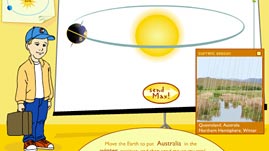Teachers' Domain - Digital Media for the Classroom and Professional Development
User: Preview

Source: Adler Planetarium & Astronomy Museum
Earth's orbit around the Sun, together with the tilt of its axis, results in periodic climate changes around the globe known as seasons. Different locations experience different types of climate changes. For example, some places have extreme seasonal changes in temperature, while others have little temperature change but may have rainy and dry seasons. This interactive activity from the Adler Planetarium explains why Earth experiences seasons and has users properly place Earth in its orbit for particular seasons.
Note that the greatest number of hours of daylight occurs on the summer solstice. During summer, daylight hours begin to shorten, and the number of hours of daylight on a given number of days after the solstice is the same as on that number of days prior to the solstice, in the spring. Also, although Activity 2 presents winter as Queensland's wet season, it is actually wetter there when it is summer in the southern hemisphere.
Earth is in constant motion. Approximately every 365 days, Earth completes one revolution around the Sun, and approximately every 24 hours, Earth completes one rotation around its axis. Because Earth's axis of rotation is not perpendicular to the plane of Earth's orbit — Earth is tilted about 23.5 degrees — the way in which the Sun's light hits Earth's surface varies during the course of the orbit. The seasons, or periodic changes in climate, that various locations on Earth experience are due to a combination of the tilt of Earth's axis and its place in its orbit.
The angle at which light strikes a surface greatly affects the amount of energy the surface receives. For example, when a flashlight is positioned directly over a piece of paper, all the light is concentrated on a given circular area of the paper, so the paper receives direct, intense light from the source. However, if the paper is tilted and the same amount of light hits it at an angle, the light is spread out over a greater area, and the intensity with which it hits that area is reduced. This idea also applies to the energy radiating from the Sun.
The direction of Earth's axis relative to the Sun changes throughout the year. When the north pole of Earth's axis is pointed towards the Sun, it is summer in the northern hemisphere and winter in the southern hemisphere. During this time of year, the northern hemisphere receives more direct sunlight than the southern hemisphere. The Sun appears higher above the horizon and its light takes a more direct path through the atmosphere. This results in less scattering of energy and more concentration of sunlight over the area — the most important factor for seasonal changes. In addition, daylight lasts longer, allowing more time for the radiation to warm the surface. Alternatively, when the North Pole is pointed away from the Sun, it is winter in the northern hemisphere and summer in the southern hemisphere.
Contrary to popular belief, variations in the distance of Earth from the Sun play a very minor role in temperature changes. Earth's orbit is nearly circular — our planet is always about 150 million kilometers (93 million miles) away from the Sun. In illustrations, Earth's orbit is commonly shown as an oval encircling the Sun — the non-circular shape is due to a perspective view of the nearly circular orbit. The change in distance between the Sun and Earth is minimal and has virtually no effect on the amount of energy Earth receives.
 Loading Standards
Loading Standards Teachers' Domain is proud to be a Pathways portal to the National Science Digital Library.
Teachers' Domain is proud to be a Pathways portal to the National Science Digital Library.
